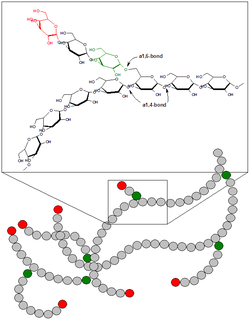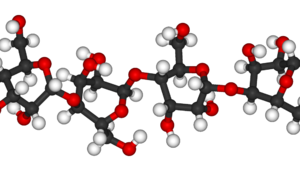Polysaccharide
| Major polysaccharides |
Other types of glucids
|
The polysaccharides are macromolecules formed by the union of a large number of monosaccharides. They are among the carbohydrates, and fulfill various functions, especially as energy and structural reserves.
Polysaccharides are polymers whose constituents (their monomers) are monosaccharides, which are joined repetitively by glycosidic bonds. These compounds reach a very high molecular weight, which depends on the number of residues or monosaccharide units that participate in their structure. This number is almost always indeterminate, variable within certain margins, unlike what happens with informative biopolymers, such as DNA or protein polypeptides, which have a fixed number of pieces in their chain, in addition to a specific sequence.
Polysaccharides can be broken down, by hydrolysis of glycosidic bonds between residues, into smaller polysaccharides, as well as disaccharides or monosaccharides. Its digestion within cells, or in the digestive cavities, consists of a hydrolysis catalyzed by digestive enzymes (hydrolases) generically called glycosidases, which are specific for certain polysaccharides and, above all, for certain types of glycosidic bond. Thus, for example, the enzymes that hydrolyze starch, whose bonds are of the type called α(1→4), cannot break down cellulose, whose bonds are of the β(1→4) type, although in both cases the monosaccharide be the same. The glycosidases that digest polysaccharides, which may be called polysucroses, generally break one bond in two, thus releasing disaccharides and allowing other enzymes to complete the job later.
In the formation of each glycosidic bond, a molecule of water "is left over", since these are formed by condensation reactions from the union of monosaccharides by covalent bonds. Likewise, in its cleavage by hydrolysis a water molecule is added to split it into multiple monosaccharides, so in a chain made of n monosaccharides, there will be n-1 bonds glycosidic. Starting from the fact that the general formula, not without exceptions, of monosaccharides is
- CxH2xOx
it is easily deduced that polysaccharides will almost always respond to the general formula:
- Cx(H2O)x-1
Classification of polysaccharides
Reserve polysaccharides
Reserve polysaccharides represent a way to store sugars without creating an osmotic problem. The main energy provider molecule for the cells of living beings is glucose. Its storage as a free molecule, since it is a small and highly soluble molecule, would give rise to severe osmotic and viscosity problems, incompatible with cell life. The organisms then keep only minimal amounts, and very controlled, of free glucose, preferring to store it as a polymer. The osmotic concentration depends on the number of molecules, and not on their mass, so the cell can, in this way, store enormous quantities without problems. Some examples of reserve polysaccharides can be: starch and glycogen.
It is important to note that reserve polysaccharides do not play the same role in immobile and passive organisms, such as plants and fungi, as they do in animals. These do not store more than a small amount of glycogen, which serves to ensure a permanent supply of dissolved glucose. For large-scale storage of reserves, animals resort to fats, which are lipids, because they store more than twice the energy per unit mass; and in addition, they are liquid in the cells, which makes them more compatible with the movements of the body. A human organism stores as glycogen the energy needed for no more than six hours, but can store as fat the energy equivalent to the needs of several weeks.
Most reserve polysaccharides are glucans, that is, glucose polymers, more precisely its hexagonal ring isomer (glucopyranose). They are mainly α(1→4) glucans, represented in plants by starch and in animals by glycogen, with chains that branch off thanks to α(1→6) type bonds. In some snails, the reserve polysaccharide for reproduction is galactogen, which differs from glycogen in other animals in that it consists of a β-linked polymer of galactose. In numerous groups of protists, β(1→3) type glucans fulfill the same reserve function.
Structural polysaccharides
These are carbohydrates that participate in the construction of organic structures. The most important are those that constitute the main part of the cell wall of plants, fungi and other osmotrophic eukaryotic organisms, that is, they feed by absorbing dissolved substances. They have no other cheaper way to support their body than by wrapping their cells with a flexible but resistant wall, against which they oppose the osmotic pressure of the cell, thus achieving a solution of the type that in biology is called hydrostatic skeleton.
Cellulose is the most important of the structural polysaccharides. It is the main component of the cell wall in plants, and the most abundant of the biomolecules that exist on the planet. It is a glucan, that is, a glucose polymer, with glycosidic bonds between its β(1→4) type residues. Due to the spatial configuration of the links involved, the glucose residues are aligned in a straight line, not in a helicoid, which is the case of α(1→4) glucans, of the starch type. This is the rule regarding the conformation of all the structural polysaccharides of the walls. These straight chains are linked transversely, by hydrogen bonds, in bundles of parallel chains.
Chitin fulfills a role equivalent to that of cellulose, but in fungi, and it is also the base of the exoskeleton of arthropods and other related animals. Chitin is a polymer of N-acetyl-2, D-glucosamine, an amino monosaccharide, which therefore contains nitrogen. Being this a chemical element difficult to acquire for autotrophic organisms, which have to administer it with stinginess, chitin is reserved for heterotrophs such as fungi, which obtain it in abundance.
Other functions
Most of the cells of any living being usually have this type of molecule on their cell surface. For this reason, they are involved in cell recognition phenomena (example: Major Histocompatibility Complex), protection against extreme adverse conditions (Example: polysaccharide capsules in microorganisms) or adhesion to surfaces (example: the formation of biofilms or biofilms, by acting as a kind of glue).
Depending on the composition
Two types of polysaccharides are distinguished according to their composition:
- Homopolisaccharides: are formed by the repetition of a monosaccharide.
- Heteropolisaccharides: they are formed by the orderly repetition of a disaccharide formed by two different monosaccharides (or, what is the same, by the alternation of two monosaccharides). Some heteropolisaccharides participate together with polypeptides (amino acid chains) of various mixed polymers called peptidoglucans, mucopolisaccharides or proteoglucans. It is essentially structural components of tissues, related to cell walls and extracellular matrices.
Tests to notice Carbohydrates
- Reaction by Benedict
- Fehling test
- Iodo test
Contenido relacionado
Nastus
Gram
Functional group


